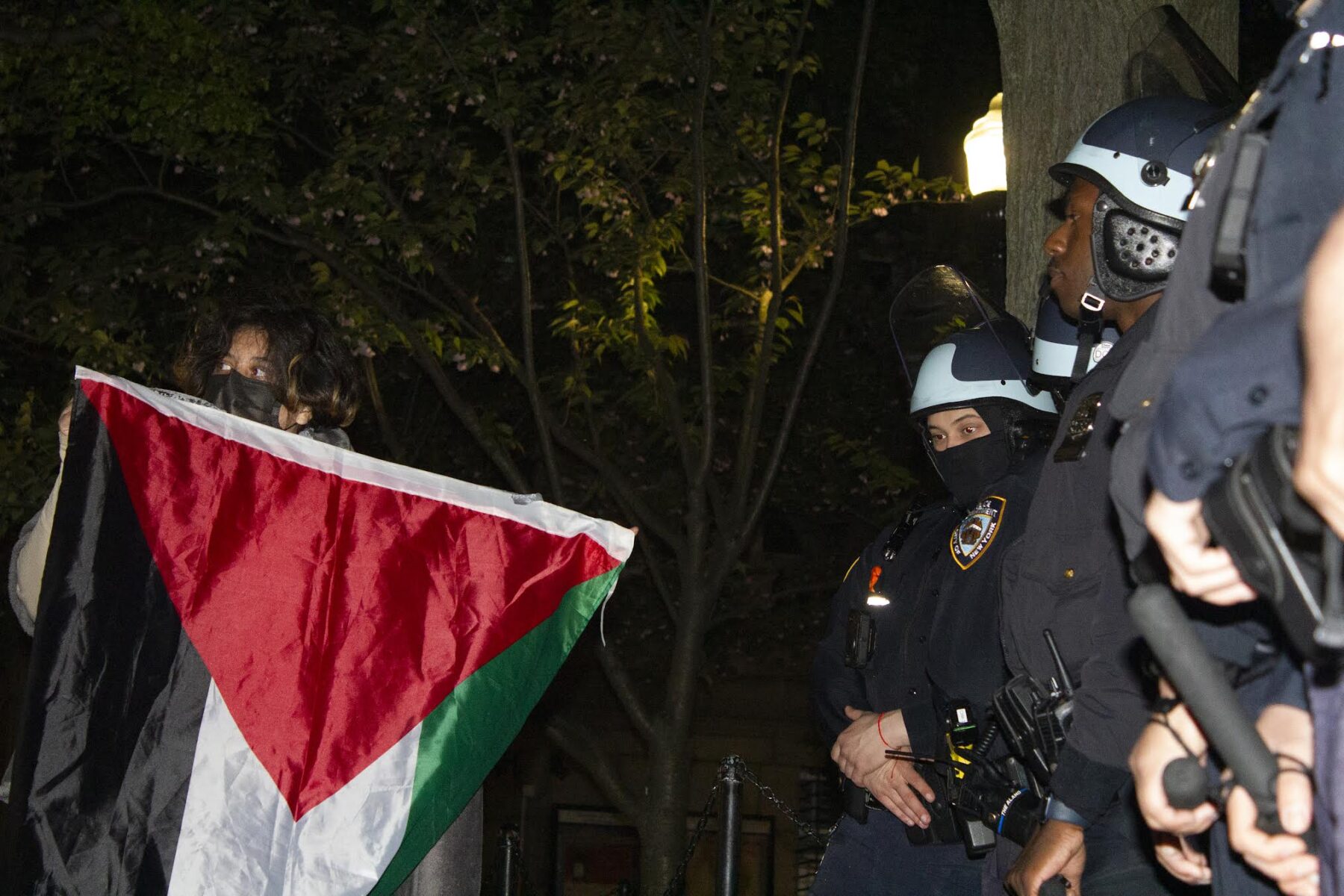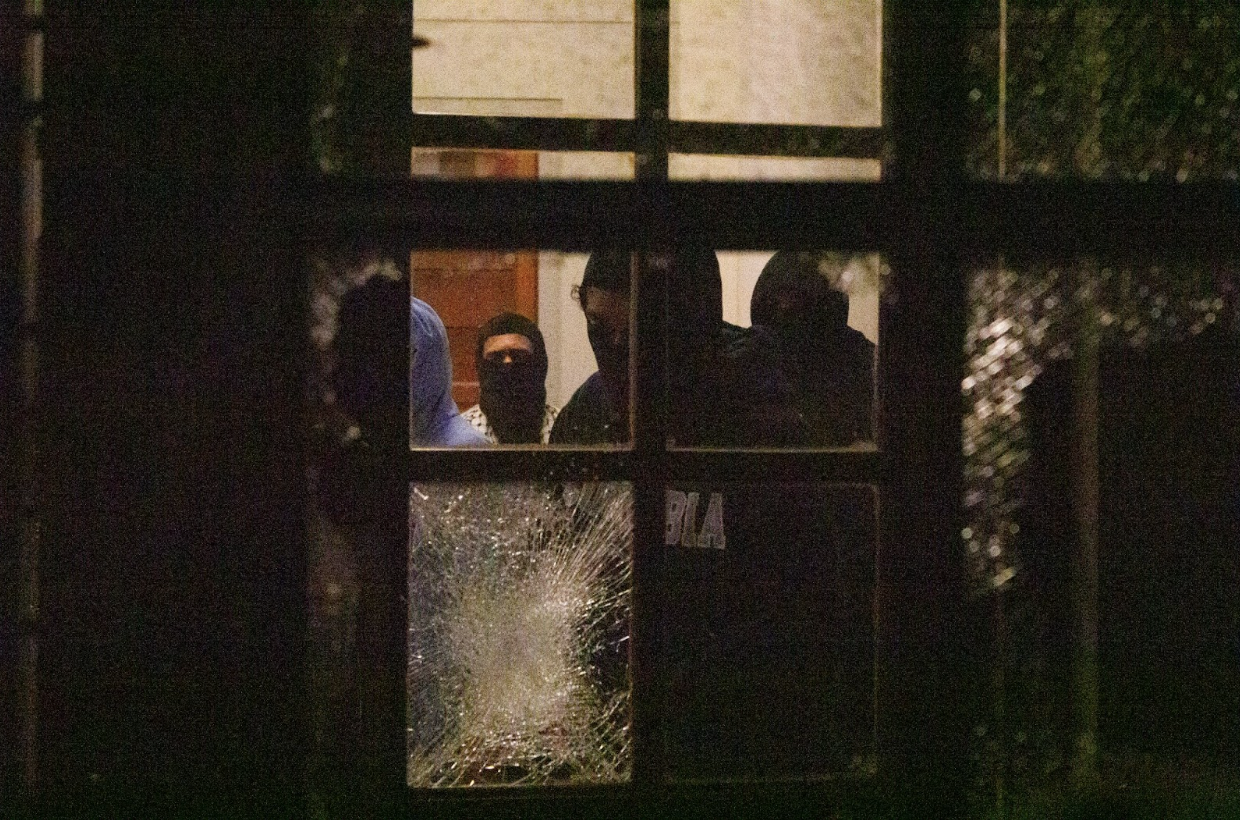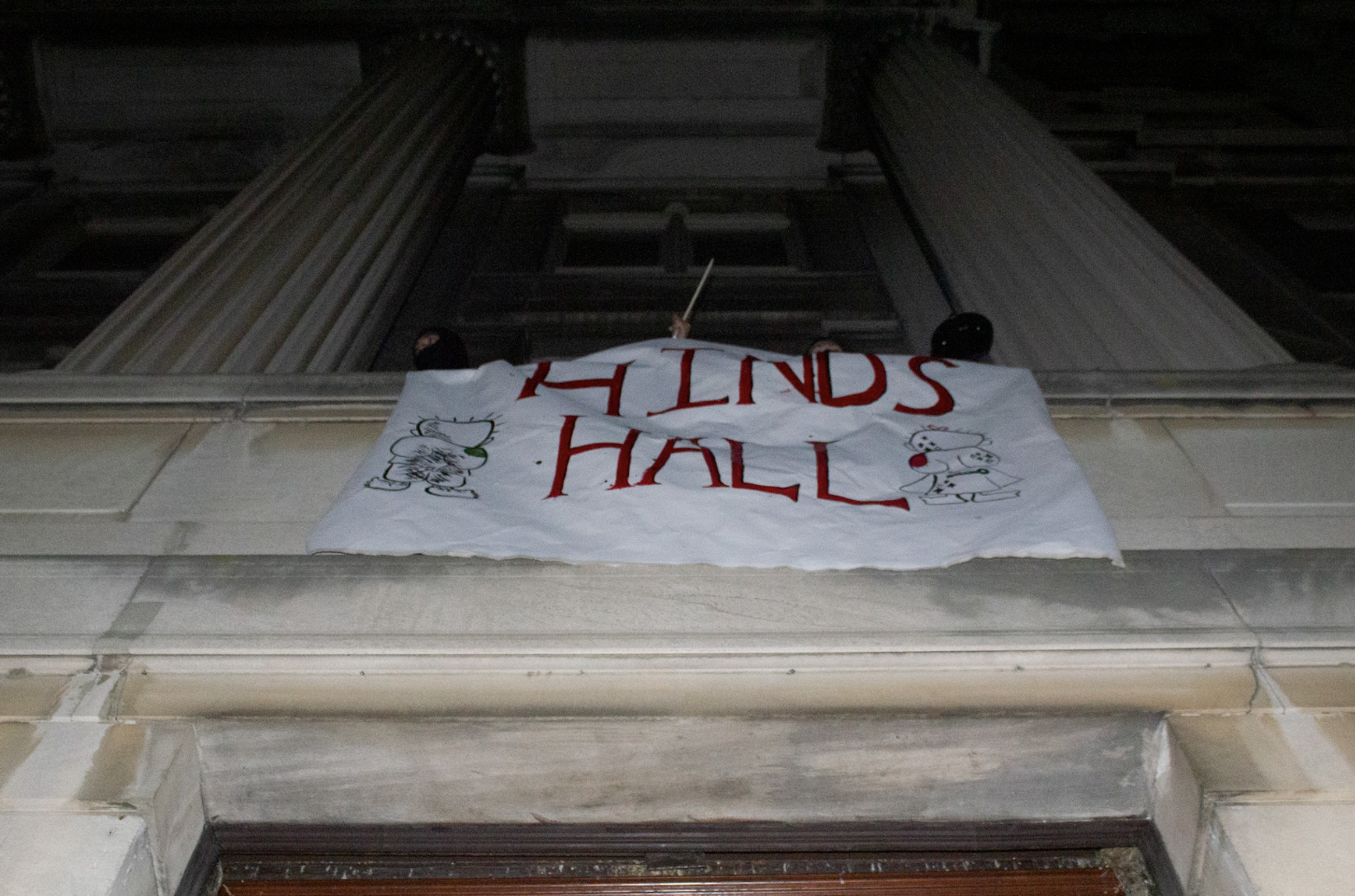
A protester holds the Palestinian flag aloft in front of NYPD officials on Tuesday, April 30, 2024 inside the Columbia University campus (Credit: Uzma Afreen)
NEW YORK — The occupation of Hamilton Hall on Columbia University’s campus lasted just under 24 hours and ended with another round of arrests.
To understand how the university and its student protesters got to this point, it helps to have some context from the previous 24 hours.
At 11:12 p.m. on Monday, organizers of the Gaza Solidarity Encampment at Columbia University sent an urgent call to mobilize. “We need you to come out now…” read the message. Unbeknownst to many of the students who showed up to join the protest at midnight, the organizers had a carefully laid out plan of action.
At half past midnight, pro-Palestine student protesters stormed into Hamilton Hall and shut the doors. Dozens of other protesters quickly interlocked elbows to form a human chain outside the building.

Student protesters break a glass pane in Hamilton Hall on Tuesday, April 30, 2024. (Credit: Uzma Afreen)
While students occupied Hamilton Hall, students set up a second encampment in solidarity with Gaza elsewhere on the university grounds. The university administration, which had just earlier in the day threatened suspensions of protesters who didn’t leave the encampment by 2 p.m., seemed to have been taken by surprise by the post-midnight maneuvers of the student protesters.
Hamilton Hall was the site of a famous week-long sit-in protest against the Vietnam War in 1968, and was occupied again, exactly 56 years later. By Tuesday night, the building was de-occupied and the nearly 100 student protesters were arrested, according to NBC.
“The students were brutalized in a disproportionate manner. We have video evidence of students being pushed down the stairs, bleeding, hurt, in separate incidents,” Sueda Polat, a senior member of Columbia University Apartheid Divest, the student coalition leading the protests, told Columbia News Service, shortly after the arrests.
“Our immediate concern is jail support,” Polat said.
Polat was one of the students who had been negotiating with the university on behalf of the protesters, until the talks were officially called off on Monday. Polat spoke to Columbia News Service at 3 a.m. on Tuesday, hours after Hamilton Hall was initially occupied by fellow protesters.
“The students took on a huge risk, they took a building,” Polat said. “But we feel that it’s worth it for Palestine. And none of this would have been necessary if not for the university’s complete ignorance of our demands.”
“There is an electricity in the air, especially with each banner dropped,” Polat said.
One such banner that was dropped over Hamilton Hall was in memory of Hind Rajab, a six-year-old Palestinian child who was killed in the ongoing war in Gaza.
“We renamed Hamilton (Hall) to Hind’s Hall,” Polat said.

Pro-Palestine protesters ‘rename’ Hamilton Hall as Hind’s Hall in memory of a six-year-old Palestinian child who died in the ongoing war in Gaza (Credit: Uzma Afreen)
“We felt that was necessary to be able to make sure Columbia understands that we are going to stay here until divestment, and nothing will stop us until divestment,” said Nawaz (name changed to protect identity), another student organizer who was involved in the post-midnight escalations by the pro-Palestine protesters.
Planning The Post-Midnight Escalation
At around 12:30 a.m. on Tuesday, the protests at Columbia diversified. Even as one group of demonstrators picketed around the central part of the campus, another group silently set up a second encampment around 500 feet away from the first one. Simultaneously, a third group stormed into Hamilton Hall.
“It had been in the planning,” said Jade (name changed to protect identity), one of the organizers at the protest.
“Everyone, you know, has different levels of information.” It was about what they “need to know and when they need to know them,” she added.
Though Jade had an understanding of what her role at the time was going to be, she said they needed to be wary of how much of the plan individual protesters knew, especially due to the large numbers of protesters involved.
“That’s the thing, in order for organizing (something) this big to work this well, there has to be a lot of coordination,” said Nawaz. “It was an entire community coming together and figuring out how to organize themselves.”
A Repeat of 1968
Nawaz said that they were following in the footsteps of the student protesters of 1968. “Hamilton Hall does have a history,” he said.
In April 1968, student protesters occupied the building to register their protest against the Vietnam War and against gentrification. They held fort for a week, before police officials were brought into the barricaded hall.
In April 2024, protesters against the ongoing war in Gaza who occupied the same building said they knew that the university might go a similar route as it did 56 years ago, by calling the police on its own protesting students.
Protesters had faced law enforcement just weeks before. On April 18, in an attempt to shut down the Gaza Solidarity Encampment set up by protesters at Columbia, the university administration authorized the NYPD to enter campus and arrest the protesting students. The NYPD conducted more than a hundred arrests that day.
What’s Next?
The administration has said that “students occupying the building face expulsion.“
Polat said it’s Gaza that is keeping them going, despite the threat of severe consequences.
“There is a deep connection to Palestine and a feeling that we are doing something generative here,” Polat said. “We’re not just taking buildings, taking lawns because we’re bored. There’s a purpose to it.”
About the author(s)
Meghnad Bose is an award-winning multimedia journalist with over 8 years of experience across digital and television news platforms.
Uzma Afreen is a multimedia journalist pursuing MS Journalism from Columbia Journalism School.
Arshi Qureshi is a broadcast journalist pursuing MA Politics from Columbia Journalism School.



